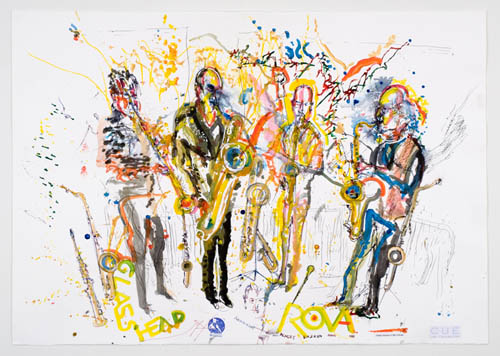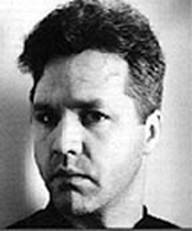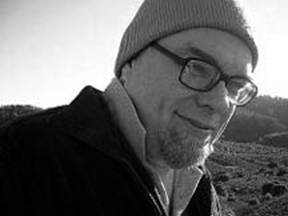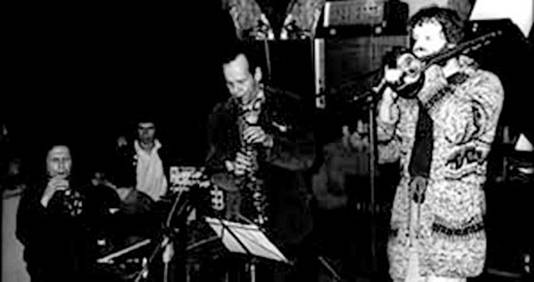
Rova’s been out on 3 road trips since late in January and now we’re around to bring it all back home…with a local Quartet show, and the first installment of Rovaté 2007. Improv:21 continues, and we have eyes for later-in-the-year developments for the band. Stay tuned.
Favorite Street: Rovaté 2007 - Steve Adams
In the last few years we?ve been exploring graphic scores in Rova. It's been very interesting investigating the possibilities of them, and checking out the history and resonances of the idea. We?re going to be presenting two concerts in the coming months at the ODC Theater in San Francisco where we will be joined by guests to perform graphic scores.
June 5, 2005 - Rova talks about Visual Influences on the Music.
[Click here to see video]
April 22, 2007 8:00pm
| Rova with: | • Joan Jeanrenaud and Theresa Wong, cellos |
| • Mark Dresser, bass | |
| • Mark Trayle, electronics |
Eye Music for Ears – Mix 2
June 10, 2007 8:00pm
| Rova with: | • Fred Frith, guitar |
| • Devin Hoff, bass | |
| • Ches Smith, drums |
3153 17 th Street (at Shotwell)
San Francisco
415-863-9834
Here are some of the visual influences I’ve been inspired by in doing these scores:
Agon Orchestra: Graphic Scores and Concepts by Petr Kofron and Martin Smolka - This book with accompanying CD documents the graphic pieces that this Czech group has played and gives detailed explanations of how they developed their interpretations of scores that range from clarity to complete ambiguity. It’s a real eye and ear opener.
Kandinsky: Watercolors and other Works on Paper by Frank Whitford - Kandinsky has been a huge inspiration to both Jon and me. There are lots of good books covering his work but this one is of particular interest since I work largely in watercolor on my scores. His use of rhythm and form and his many ways of expanding a personal language never fail to excite.
The Splendor of Islamic Calligraphy by Abdelkebir Khatibi and Mohammed Sijelmassi - The idea of calligraphy connects to traditional music notation and has been a way for me to think about new notational possibilities. Islamic calligraphy has been developing in many surprising ways for centuries.
Brion Gysin: Tuning in to the Multimedia Age edited by José Férez Kuri - Gysin was a collaborator of William Burroughs and Steve Lacy and is probably best known as a writer. But he also had an equally interesting career as a visual artist, including a large series of paintings that are working from calligraphy. He took the idea to some unique and beautiful places.
Hans Richter: Activism, Modernism and the Avant-Garde edited by Stephen C. Foster - Richter did many things in his long career including, like Kandinsky, creating visual art that connected to music. I’m fascinated by the development and variation in his Constructivist pieces. Produced by Rova:Arts, Improv:21is an ongoing series of “informances” on twenty-first century music exploring the connections between composition and improvisation. SFPALM, in association with Other Minds , is pleased to co-sponsor the 2006-2007 season. The series is led by master improvisers and composers from the Bay Area and beyond.
Hosted by Derk Richardson
Monday, April 9 - 7:00 pm
Chris Brown & Tim Perkis: “Machines and Others”
Conversation and Performance
 |
 |
|
| Chris Brown | Tim Perkis |
The sixth program of the season features Tim Perkis and Chris Brown, whowill talk with host Derk Richardson about issues involved in improvising with their self-designed computer music instruments in different contexts: in ensembles that include acoustic instruments; in all-electronic groups (like "The Hub", the legendary computer network music band of which they are members); and in solo pieces. The relationship of composition to improvisation in live computer music will also be explored, both in conversation, and in a short set of solos and a duo they will perform.
CHRIS BROWN, composer, pianist, and electronic musician, creates music for acoustic instruments with interactive electronics, for computer networks, and for improvising ensembles. Collaboration and improvisation are consistent themes in his work, as well as the invention and performance of new electronic instruments. These range from electro-acoustic instruments (“Gazamba”, 1982), to acoustic instrument transformation systems (“Lava”, 1992), and audience interactive FM radio installations (“Transmissions”, 2004, with Guillermo Galindo).
TIM PERKIS has been working in the medium of live electronic and computer sound for many years, performing, exhibiting installation works and recording in North America, Europe and Japan. His work has largely been concerned with exploring the emergence of life-like properties in complex systems of interaction.In addition, he is a well known performer in the world of improvised music, having performed on his electronic improvisation instruments with over 100 artists and groups.
All Improv:21 informances are at 7:00 pm and take place at:401 Van Ness Avenue (@ McAllister)
Veterans Building, 4th Floor
Directions to SFPALM
Admission is $10. Space is limited and paid reservations are recommended. Call 415-255-4800 or purchase online at www.sfpalm.org.
Watch for details on future Improv:21 informances with:
Bob Ostertag, Joan Jeanrenaud & Willie Winant and others.
rova.org/improv:21
Rova
The Jazz School - Berkeley
2087 Addison Street
Downtown Berkeley
(510) 845-5373
Tickets by Phone :
1-866-384-3060, Monday–Friday 9am – 5pm
2 Sets
With Jason Weiss, author of Conversations with Steve Lacy
Ensemble Room, Music Building
Admission: FREE
Mills College
5000 MacArthur Blvd.
Oakland
510-430-2331
— and —
Poetry Center , HUM 512
Admission: FREE
San Francisco State University
1600 Holloway Avenue
San Francisco
415-338-2227
sfsu.edu
21 Grand
416 25th St @Broadway
Near 19th Street BART
Oakland
8:00 Vinny Golia - Karen Stackpole duo
8:45Citta di Vitti with
Phillip Greenlief – alto saxophone
Lisa Mezzacappa - contrabass
Jason Levis – drums
9:30 Vinny Golia - Steve Adams duo
(Frank Gratkowski, Phillip Greenlief, Jon Raskin)
CNMAT
1750 Arch Street
Berkeley
For the second year in a row, saxophonists Phillip Greenlief & Jon Raskin are presenting a series of concerts in which the 2 saxophonists invite a pair of “like instruments” to join them to explore new directions in composition and improvisation.
Wednesday, March 21 8:00pm
Phillip Greenlief, Jon Raskin (saxophones) with Aurora Josephson & Dina Emerson (voices). Upcoming shows in the series will feature (in April) Ignaz Schick & David Kendall – electronics, and in May John Hanes & Gino Robair (percussion).
416 25th Street (near Broadway)
Oakland
(510) 444-7263
http://www.21grand.org/
Tickets prices are $8 - $15, sliding scale
21 Grand
416 25th Street (near Broadway)
Oakland
(510) 444-7263
http://www.21grand.org/
Tickets prices are $8 - $15, sliding scale
Yumi Hara will perform solo and in combination with the JR Quartet. http://www.myspace.com/yumiharacawkwell
George Cremaschi, bass & electronics
Gino Robair, percussion & electronics
Jon Raskin, saxophones
Laudatio: Steve Lacy - Alvin Curran
by Alvin Curran

Steve Lacy, center, and Curran far left, with Musica Elettronica Viva
Rome 1977 (photo: Roberto Masotti)
ROME — For anyone who has not played the Dixieland standards — say, Muskrat Ramble, Fidgety Feet, Sister Kate, Black and Blue, Rampart Street and Moldy Fig Stomp (that one I made up) — there’s no postmodern theory that can beat it. Derrida, a great jazz buff, as George Lewis assures me, knows where Les Orleans Nouveaux are, but Baudrillard, a sometime Americanophile, probably doesn’t know the changes.
This much I got out of just reading a heart-rending, ear- and eye-opening book, Steve Lacy, Conversations (Duke Univ. Press , ed. Jason Weiss, 2006). It is a knock-out, an omelette aux fines herbes, an impeccable Lacy line of weird angles and implied major seconds. A bag full of Dixie, borscht-belt air, Cecil Taylor, Thelonious Monk, Gil Evans, Musica Elettronica Viva, the road, Rome, Paris, New York, Asia, Boston, backstage philosophy, painters, poets and corduroy. A life of roaming music lessons on stage and in the streets, in museums and at home — compositions all, that most professors have long excluded from their curriculae. No sour grapes nor sentimental journey in this book, just the pure straight dope.
Steve’s erudite and smart words, thousands of which I exchanged with him over nearly four decades — like his crystalline notes, loony melodic contours, say-what repetitions, clusters containing the whole Ellington book, durations of long disappeared tribes, texts of every major poet, and dedications galore — sent me scrambling into my own scrapbook of similarly shared experiences …
When Steve entered the “studio” and music of the mythical group Musica Electro nica Viva (MEV) in Rome in 1968 it was as if the entire Mississippi Delta had washed in on us. As an ex-jazzer I could appreciate the pristine sound, the noble dignified inflection of his music, speaking in time, out of time, in repeatable syntax, in tongues, in Babe Ruth swats and almost inaudible overtone seductions. Here he was passing through a natural way-station, a grimy old metal factory in Rome’s Trastevere quarter, which MEV in the form of Frederic Rzewski, Richard Teitelbaum, Carol Plantamura, Allan Bryant, Jon Phetteplace, Ivan Vandor and myself had nearly brought down on our own heads by amateurishly widening a structural arch to connect two main rooms.
Rich with projects but low on cash, Steve, along with Irene Aebi, moved in and seldom paid the rent. Threatened with losing the place Teitelbaum and I went one day like two tough landlords to collect from them. Steve listened to all the arguments – how much we had sweated, invested and put into this place and looking down boyishly at his left foot, as he often did when offering major replies, said, “… Man, but you have no idea how many notes I put into these walls … millions!”
Steve came up with these life-saving retorts time and time again – poetic truths so simple and evident that even the sewer-rats applauded when he pronounced one. There was no comeback to the million notes in the walls, and as far as I know that locale, now the studio of a group of painters I know, is still alive with the remarkable sounds that Steve was producing daily in the millions – practicing on end to master the devilish soprano saxophone and to amalgamate his solid jazz self with the most open forms of musical liberation and creative anarchy that were the central themes of the day.
Playing with MEV, in exchange for our riffs on sheets of grating glass, amplified springs, and various found-objects, mixed with unearthly oscillators, Steve would simply drop a honked low A-flat or hang a heavenly mid-range long tone like he was causally hanging the wash on a line, then heave air-brakes like a Mack truck about to hit a goose caught by a hyena, or send out an anomalous phrase that sounded like all God’s chillun’ were singing in unison.
Against the MEV “casino” of sound it all made perfect sense, perfect “Arte Povera.” But, the MEV theology which vaunted no leaders, no scores, no authority, no beginning or end, now had “melody” — certainly a bourgeois artifact to be avoided, but coming out of Steve’s horn, a blessing and a remarkable alternative to the group’s penchant to construct walls of earsplitting noise in crescendo. This time it was Steve Lacy who brought the whole history of music up the Tiber and dropped it in Via Peretti right in the laps of a bunch of Ivy League runaways.
There, Steve began his life as a composer in earnest. A born melodist crafting lines of incomparable invention, the beginnings of his endless songbooks – band-books of life. We all learned from him as he from us, and while Rzewski could speak ancient Greek and nouveau-Marx, Lacy was talking Cecil and Monk, Akhmatova and Gyson. The dialogue was convulsive as it was serene. MEV, the quintessential experimental composers’ performing group was becoming via Lacy, and then with Garrett List (trombone), a meta-Dixieland band with roots in the mud of all the rivers, the Tiber to the Mississippi, the Rhine to the Ganges, the Jordan to the Yangtze. Pure flowing postmodern theory in practice. Maybe what Mozart would have invented – between fart jokes – had he been in our so-called utopian shoes.
Though Steve’s music and life had other places to go, when called, he always made time to return to the unkempt MEV project between 1970 and 2002, often using it as a musical launching pad for his compositions to uncharted destinations. But in typical fashion as Rzewski wrote to me: “I remember phoning S. once, maybe sometime in the 80’s, to tell him “There’s another MEV gig!” From the other end of the line, after a moment’s pause, came an agonized groan: “Ooh, Nooo…”
Never, other than in the coherence and clarity of the composer Cornelius Cardew, have I encountered a musical poet of such unruffled purpose as Steve. He lived on the same ill-famed streets where all music lives, the obscure and even dangerous ones, where you only emerge by disappearing into your own sounds late at night letting in their precious air and light.
Outside the MEV experiences I had the pleasure to work with Steve in some unusual ventures of my own, in which he recognized his immediate affinity and utility. The first was an LP of songs which I had written and arranged for the politically engaged music-theater singer Maria Monti, “Il Bestiario” (The Bestiary, 1974-5), with texts by the renowned poet Aldo Braibanti – a set of pithy and airy songs over which Steve added unforgettable commentaries. He was also a natural choice for my 1985 National Public Radio “Maritime Rites” series, now on New World Records, as one of the illustrious colleagues (Pauline Oliveros, John Cage, George Lewis among them) to solo against my recorded soundscapes of the eastern United States seaboard.
I recorded him playing his “Coastline” (based incidentally on the contour of the sea view he had from his get-away house in Sperlonga ) in a closet somewhere in Bologna 20 minutes before he was to appear in a solo concert. And then in a radio work, “For Julian,” (1987) — commissioned by Klaus Schoening of the WDR Studio Akustische Kunst, Cologne — where with a mixed chorus, Steve answered my plaintive shofar calls with his biblical soprano sax. This work, in memory of our mutual friend Julian Beck — co-founder of the Living Theater — received the first Ars Acustica prize for Radio Art in 1988.
So here was this chubby Upper-West-Side kid, who in the 1950s I heard play at Brown University with the Max Kaminsky’s Dixieland Band and the next thing I know he is a MacArthur genius — patiently and intently bringing the entire treasure of Western modernism into the exploding crucible of Afro-American music, and vice-versa. Who could ever have imagined that the elegant quasi one-note “Basin St. Blues” contained such potent changes? Thanks, Steve
Derek Bailey's On the Edge TV programs produced for Chanel 4 in England:
http://www.ubu.com/fil m/bailey.html
This show is in 4 one-hour parts. Part 1 and 2 are ESSENTIAL viewing for anyone working with or listening to improvised music.
Record Making With Duke Ellington, featuring the 1937 era Ellington Orchesra:
http://www.youtu be.com/watch?v= hjKlFFp4-IE
a short but wonderful “how to” documentary on the making of an actual record in 1937
